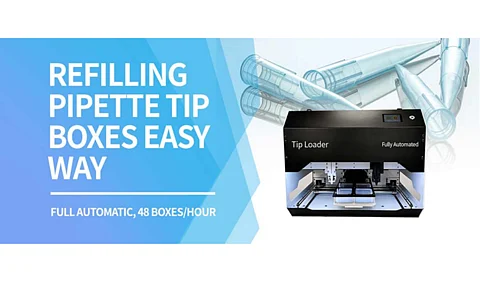Tip Loader Types
There are many types of tip loaders to satisfy varied laboratory needs, but their core function is the same. Speed, capacity, and pipette tip compatibility distinguish models.
1. Manual Tip Loaders: Manual tip loaders are beginner devices that require manual input. While they automate tip alignment and placement, the technician may still need to manually feed the tips into the machine. These systems fit low-throughput or small-scale labs.
2. Automatic Tip Loaders: Fully automatic tip loaders require little manual labor. These machines are useful for high-throughput pharmaceutical research and clinical testing labs because they can handle many pipette tips at once. Faster, more efficient automated machines can replenish numerous racks without operator help.
3. Universal Tip Loaders: Many pipette tip sizes can be loaded into certain tip loaders. These universal variants can accommodate numerous tip brands and diameters, making them perfect for labs that employ multiple pipettes.
4. High-Capacity Tip Loaders: High-volume laboratories can load thousands of tips every cycle with high-capacity tip loaders. These larger, quicker systems satisfy the needs of large-scale industry and research.
Advantages of Tip Loaders
In labs that need efficiency, accuracy, and speed, tip loaders are beneficial. Here are the main lab tip loader benefits:
1. Efficiency in time: The main benefit of tip loaders is time savings. Manually loading pipette tips is slow and repetitive, especially when many are needed. An automated tip loader saves lab workers time reloading tip racks, letting them focus on more important tasks.
2. Increased Productivity: Automatic tip loaders allow labs to process more tips faster. Since technicians can spend less time on mundane duties and more on experiments, research, and other lab operations, productivity increases.
3. Reduced Human Error: Misalignment, contamination, and not loading enough pipette tips onto a rack can result from manual loading. Tip loaders are precise and consistent, minimizing human error and aligning and placing each tip on the rack.
4. Improved Hygiene and Contamination Control: Labs are concerned about contamination, especially when handling sensitive samples or reagents. A tip loader lowers pipette tip contact, reducing contamination risk. This keeps the tips sanitary and ready for use, protecting your lab processes.
5. Cost-Effectiveness: A tip loader may seem expensive at first, but the long-term benefits may outweigh it. A tip loader can save your lab time and money by minimizing manual activities and enhancing productivity. Improved tip loading accuracy lowers wasted tips, saving money.
Selecting a Lab Tip Loader
To choose the best tip loader for your lab, consider these factors:
• Capacity: Find out how many tips your lab uses daily. High-throughput labs may need automated or high-capacity loaders.
• Ensure tip loader: compatibility with pipette tip sizes and kinds used in your lab.
• Factor in tip loading speed: when refilling tip racks. For fast processing, use an automated or high-speed model.
• Ease of Use: Choose a tip loader with simple controls and clear instructions for easy maintenance.
• Budget: Select from manual to fully automated models based on your lab's demands and budget.
Conclusion
Modern labs benefit from tip loaders' efficiency, accuracy, and productivity. A tip loader streamlines pipette tip loading, decreasing human error and contamination concerns in typical lab work or high-throughput environments. A tip loader will save your lab time and money, letting it focus on more vital research and testing.


